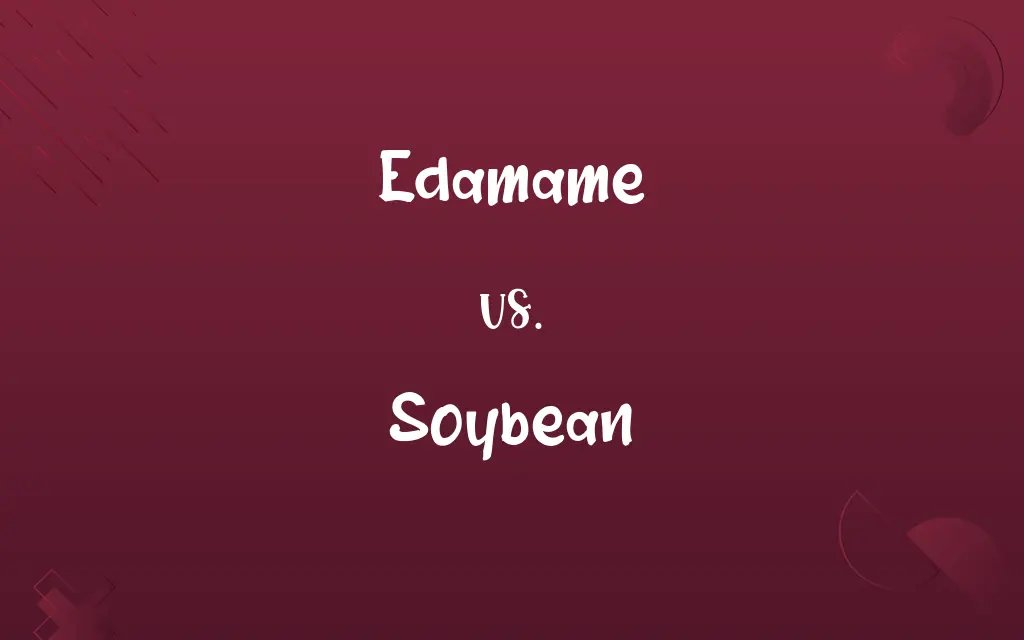Edamame vs. Soybean: Know the Difference

By Shumaila Saeed || Published on February 20, 2024
Edamame are young, green soybeans harvested early for their soft texture, while soybeans are mature, dried beans used in various products.

Key Differences
Edamame refers to immature soybeans, still green and tender, often served in pods as a snack or appetizer. In contrast, soybeans are the mature, fully grown beans, typically harvested when the pods turn brown and the beans inside are firm.
Shumaila Saeed
Feb 20, 2024
Edamame is celebrated for its soft, buttery texture and is a popular dish in East Asian cuisine. Soybeans, on the other hand, are versatile and used globally in a variety of forms, including tofu, soy milk, and soy sauce.
Shumaila Saeed
Feb 20, 2024
Nutritionally, edamame is rich in protein and fiber and often eaten whole. Soybeans, being more mature, are processed into various food products and oils, and are a staple in plant-based diets.
Shumaila Saeed
Feb 20, 2024
The preparation of edamame is simple, usually boiled or steamed and served with salt. Soybeans require more processing, often fermented or pressed for oil.
Shumaila Saeed
Feb 20, 2024
While edamame is typically consumed fresh or frozen, soybeans are often found dried, as well as in processed forms like meal or oil.
Shumaila Saeed
Feb 20, 2024
ADVERTISEMENT
Comparison Chart
Nutritional Content
High in protein and fiber
Used in various dietary products
Shumaila Saeed
Feb 20, 2024
ADVERTISEMENT
Edamame and Soybean Definitions
Edamame
Immature soybeans served as an appetizer.
Edamame, seasoned with salt, was served first.
Shumaila Saeed
Jan 17, 2024
Soybean
The primary source of soy milk and soy sauce.
Soybeans were ground to make soy milk.
Shumaila Saeed
Jan 17, 2024
Soybean
A species of legume native to East Asia.
Soybean is a key ingredient in tofu.
Shumaila Saeed
Jan 17, 2024
Edamame
Young soybeans in the pod.
We snacked on edamame at the sushi restaurant.
Shumaila Saeed
Jan 17, 2024
ADVERTISEMENT
Soybean
Cultivated for its protein-rich seeds.
The farm grew soybeans for animal feed.
Shumaila Saeed
Jan 17, 2024
Soybean
Mature beans used in various food products.
Soybean oil is commonly used for cooking.
Shumaila Saeed
Jan 17, 2024
Edamame
Boiled or steamed young soybeans.
Edamame was the perfect light snack.
Shumaila Saeed
Jan 17, 2024
Soybean
A bean processed into meal and oil.
Soybean meal is a high-protein animal feed.
Shumaila Saeed
Jan 17, 2024
Soybean
An annual leguminous plant (Glycine max) native to East Asia, widely cultivated for its seeds, which are used for food, as a source of oil, and as animal feed.
Shumaila Saeed
Jan 15, 2024
Soybean
A legume plant (Glycine max), commonly cultivated for human and animal consumption and as a nitrogen-fixing ground cover.
Shumaila Saeed
Jan 15, 2024
Soybean
An Asiatic leguminous herb (Glycine max, formerly Glycine Soja) the seeds of which (also called soy beans) are used in preparing the sauce called soy. Called also soya bean and soya.
Shumaila Saeed
Jan 15, 2024
Soybean
The seeds of the Glycine max, which produce soybean oil; - called also soya bean.
Shumaila Saeed
Jan 15, 2024
Soybean
Erect bushy hairy annual herb having trifoliate leaves and purple to pink flowers; extensively cultivated for food and forage and soil improvement but especially for its nutritious oil-rich seeds; native to Asia
Shumaila Saeed
Jan 15, 2024
Repeatedly Asked Queries
What are soybeans?
Soybeans are mature beans used in various food products and oils.
Shumaila Saeed
Feb 20, 2024
Is edamame the same as regular soybeans?
No, edamame is the young, green form of soybeans.
Shumaila Saeed
Feb 20, 2024
What is edamame?
Edamame are young soybeans, green and tender, often eaten in the pod.
Shumaila Saeed
Feb 20, 2024
Can you eat soybeans raw?
No, mature soybeans are usually not eaten raw due to their hardness and potential anti-nutrients.
Shumaila Saeed
Feb 20, 2024
How do you prepare edamame?
Edamame is typically boiled or steamed and served with salt.
Shumaila Saeed
Feb 20, 2024
Are soybeans healthy?
Yes, soybeans are nutritious, providing protein, fiber, and various vitamins.
Shumaila Saeed
Feb 20, 2024
What products are made from soybeans?
Soybeans are processed into tofu, soy milk, soy sauce, and more.
Shumaila Saeed
Feb 20, 2024
Is soybean oil a common cooking oil?
Yes, soybean oil is a widely used cooking oil due to its neutral flavor and high smoke point.
Shumaila Saeed
Feb 20, 2024
Is Edamame healthy?
Edamame is considered a healthy food as it is low in calories, high in protein, and a good source of vitamins and minerals.
Shumaila Saeed
Feb 20, 2024
Can you eat the Edamame pod?
While the pod is edible, most people only eat the beans inside, not the pod itself.
Shumaila Saeed
Feb 20, 2024
Can you buy frozen Edamame?
Yes, frozen Edamame is widely available in grocery stores and can be easily prepared at home.
Shumaila Saeed
Feb 20, 2024
What is the nutritional value of soybeans?
Soybeans are rich in protein, fiber, vitamins (like B vitamins), and minerals (like iron and calcium).
Shumaila Saeed
Feb 20, 2024
Are all soybeans green like Edamame?
No, mature soybeans are typically yellow, while Edamame are green and immature.
Shumaila Saeed
Feb 20, 2024
Can soybeans be used to make non-dairy alternatives like soy milk and tofu?
Yes, soybeans are a primary ingredient in non-dairy products like soy milk, tofu, and soy-based cheese.
Shumaila Saeed
Feb 20, 2024
Are soybeans genetically modified (GMO) in most cases?
Many soybeans are genetically modified, but non-GMO varieties are also available.
Shumaila Saeed
Feb 20, 2024
Is Edamame a common ingredient in Asian cuisine?
Yes, Edamame is commonly found in Japanese and other Asian cuisines.
Shumaila Saeed
Feb 20, 2024
Are soybeans suitable for people with dietary restrictions?
Soybeans are suitable for many dietary restrictions, as they are naturally gluten-free and a good source of plant-based protein.
Shumaila Saeed
Feb 20, 2024
Share this page
Link for your blog / website
HTML
Link to share via messenger
About Author
Written by
Shumaila SaeedShumaila Saeed, an expert content creator with 6 years of experience, specializes in distilling complex topics into easily digestible comparisons, shining a light on the nuances that both inform and educate readers with clarity and accuracy.




































































